Did you know Wales boasts an impressive 427 castles, with Cadw managing 44 of them? The Norman invasion of Wales was a significant turning point in the country’s history. Powerful Norman lords established marcher lordships and castles to control and expand their territories. These Norman castles built in Wales, initially motte-and-bailey structures, later became stone fortresses, symbolising Norman power in Wales.
The strategic locations of these Norman military architecture along key trade routes, waterways, and border regions solidified Norman influence. Yet, they also faced resistance and adaptation from The Fierce Welsh Rebellion. These castles served not just as defensive fortifications but also as centres of administration, justice, and trade. They profoundly shaped the social, economic, and political fabric of medieval Wales.
The Norman Conquest and the Establishment of Marcher Lordships in Wales
Following the Norman Conquest, William the Conqueror strategically appointed his most trusted allies to key roles along the Welsh border. These Marcher lords, like William fitz Osbern at Hereford, Roger of Montgomery at Shrewsbury, and Hugh of Avranches at Chester, were granted significant power. They controlled county towns and were allowed to govern their domains as mini-states.
William the Conqueror’s Strategy for Controlling Welsh Territories
William the Conqueror’s plan to control Welsh territories involved creating Marcher lordships. These lordships acted as a buffer zone between England and Wales. The Marcher lords were tasked with spreading Norman influence across the region. William fitz Osbern, stationed at Hereford in 1067, quickly expanded Norman control in south-east Wales.
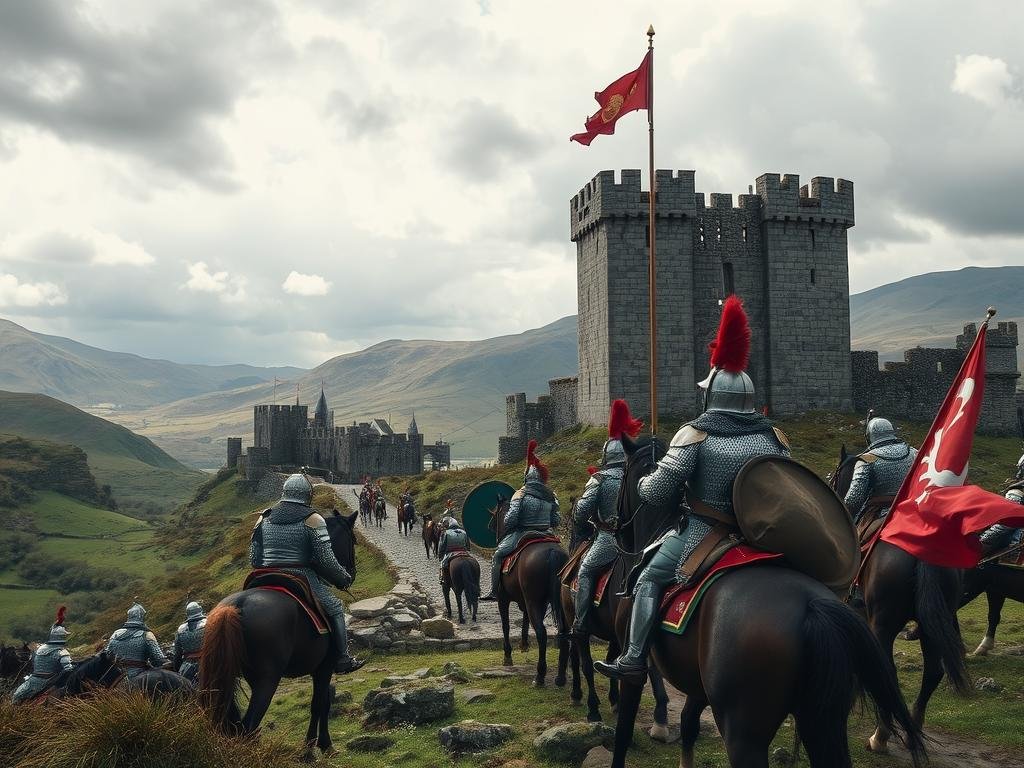
The Role of Marcher Lords in Expanding Norman Influence
The Marcher lords were essential in expanding Norman influence in Wales. From the late-eleventh century, lands were given to Norman kin and followers. The Marches covered areas in South Wales, along the coast from the river Wye to Pembrokeshire’s headlands, and along the modern England-Wales border. These rural areas were prime for urban growth, with Norman aristocrats building castle-towns at the Norman-Welsh border.
“The distribution of motte-and-bailey castles in Wales by the Normans reflected the extent of military conquest and subjugation.”
By Henry II’s end, Wales was divided between Marcher lords and Welsh principalities, a division that would last until Edward I’s conquests in 1277. Castle-building often accompanied the founding of towns on Marcher lordships. For instance, a Norman motte-and-bailey castle was built in Swansea around 1100, overlooking the Tawe River. The market at Wind Street became the main trading centre (just 8 miles away from where I live).
Early Norman Castles Built in Wales: Motte-and-Bailey
Following the Norman Conquest of England in 1066, the Normans extended their reach into Wales. The full-scale invasion of Wales began in 1081, but the Normans swiftly started building motte-and-bailey castles. These timber fortifications were built for quick construction, helping the Normans secure their early victories and control over Wales.
Motte-and-bailey castles featured a mound (motte) with a wooden tower, and an attached enclosure (bailey) surrounded by a ditch, bank, and wooden palisade. The motte offered a strategic viewpoint and was the lord’s residence. The bailey, on the other hand, housed supplies, horses, and troops. These early Norman castles built in Wales were constructed using forced labour, making them an economical option for fortification. Interestingly, only 7% of mottes in England and Wales were over 10 metres (33 feet) tall, with most (69%) being less than 5 metres (16 feet) tall.
The Rapid Construction of Timber Castles
The motte-and-bailey castles’ speed of construction was a significant advantage. Their construction time varied, with larger mottes like Thetford Castle requiring 24,000 man-days of work, and smaller ones needing as little as 1,000 man-days. This rapid construction enabled the Normans to establish a network of fortifications across Wales, solidifying their control.
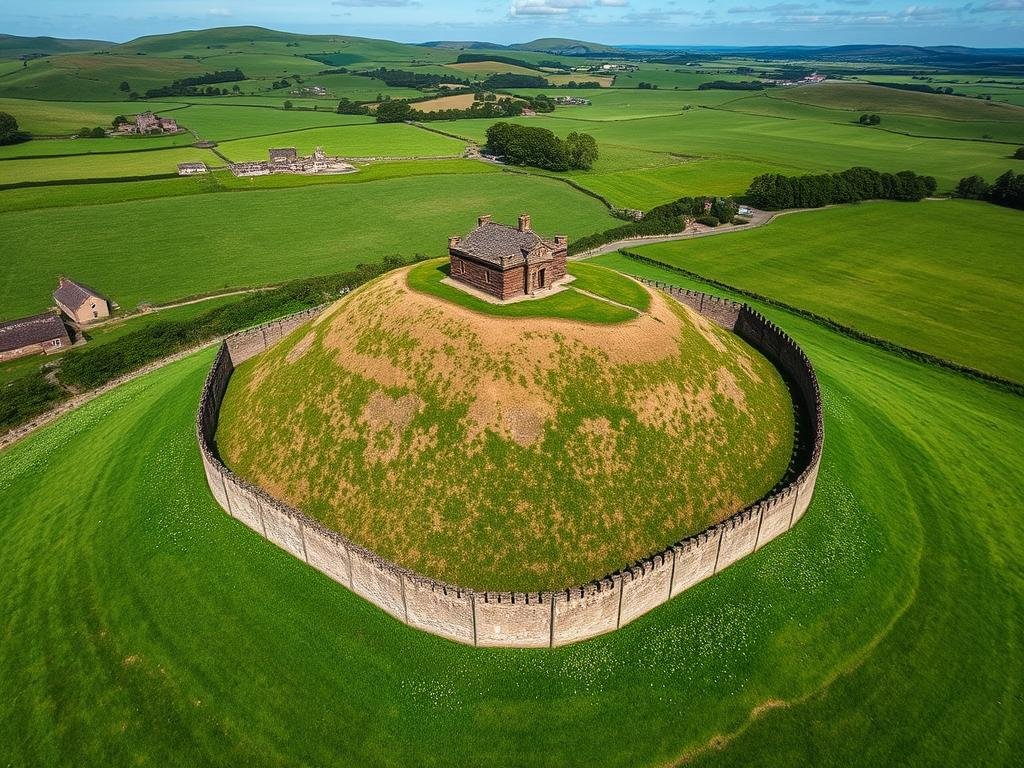
By the end of the 13th century, the motte-and-bailey design was largely replaced by more advanced fortifications. Yet, the impact of these early Norman castles on Wales’ landscape and society is immense. They symbolised Norman authority and played a key role in Wales’ subjugation, setting the stage for centuries of Norman rule and influence.
The Transition to Stone Castles in the 12th Century
The Normans, having solidified their hold on Wales in the 12th century, shifted from timber to stone fortifications. This change was a significant step in their defensive strategies and their assertion of power over Welsh territories.
Stone construction offered numerous advantages over timber. Stone castles were more durable and resistant to fire, providing enhanced protection against Welsh attacks. They required less upkeep and could endure for centuries (the well preserved castles we see in Wales today), symbolising Norman dominance.
The Norman Castles built in Wales would be forever more made of Stone. They could also be constructed larger and taller, improving their defensive capabilities and presence in the landscape.
Chepstow Castle, built by William fitz Osbern between 1067 and 1071, is a prime example of Norman stone architecture in Wales. Its strategic location along the River Wye made it a critical stronghold in the region. More on this below.
Norman Castles Built in Wales as Symbols of Power and Control
Following the Norman Conquest, the strategic placement of castles across Wales became a powerful symbol of Norman dominance. These fortresses, with their grand architecture and commanding views, were built to intimidate and assert Norman control. They were designed to show the locals who was in charge.
The Normans understood the need for a network of castles across Wales to demonstrate their military and political strength. This move was aimed at subjugating the Welsh people and solidifying their rule over the conquered territories.
Wales, with over 600 castles, holds the record for the highest concentration of castles per square mile globally. This figure highlights the Normans’ relentless drive for power and their strategic use of castles as symbols of control. Iconic Norman castles in Wales include:
Caernarfon Castle, a UNESCO World Heritage Site and the birthplace of Edward II, the first English Prince of Wales- photo below.
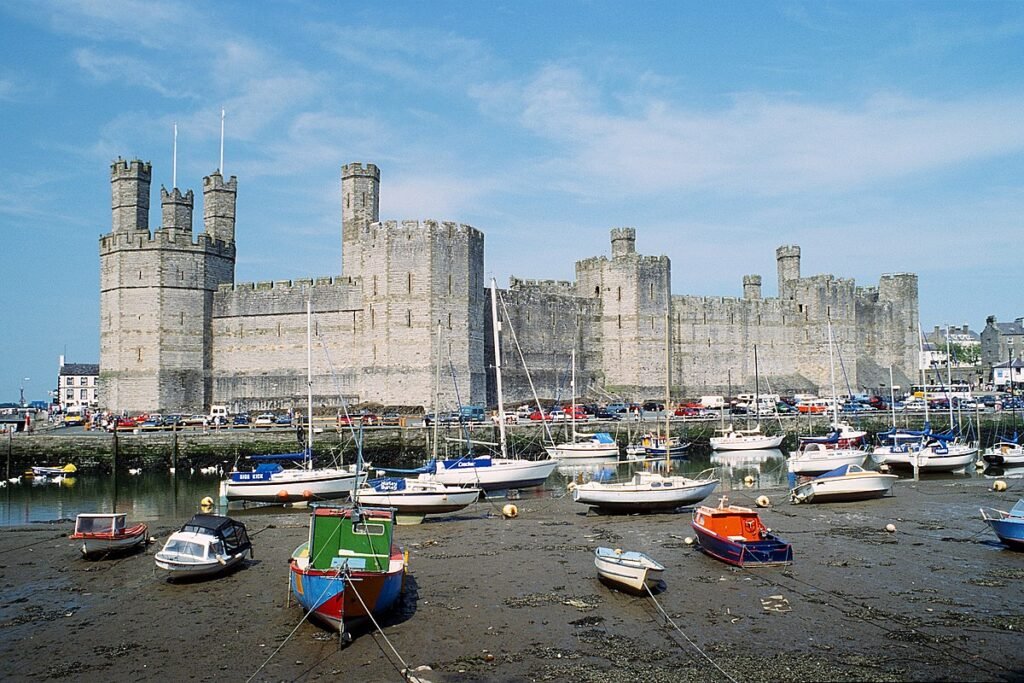
Conwy Castle, renowned for its well-preserved walls and towers that showcase the architectural prowess of the era- photo below
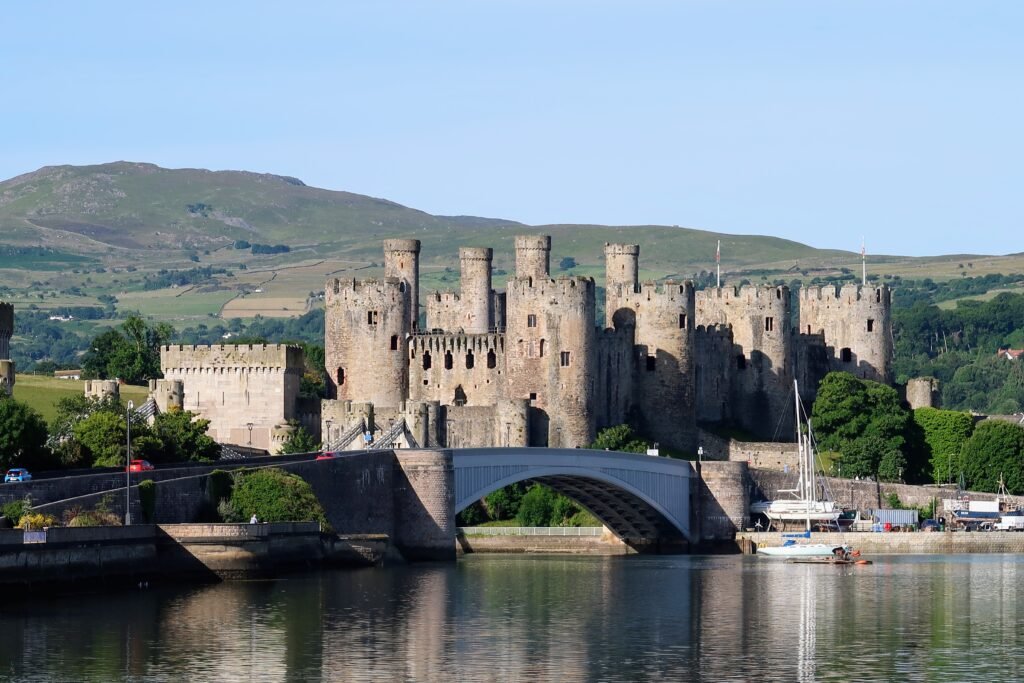
Pembroke Castle, the birthplace of Henry VII, founder of the Tudor dynasty – image below
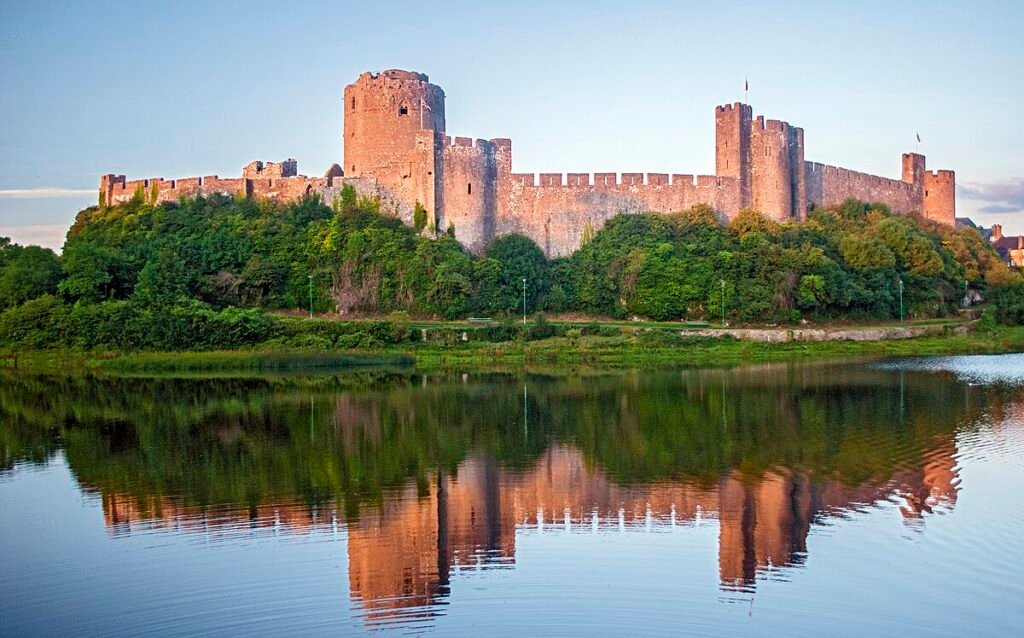
The construction of these castles was a significant investment, with some, like Conwy Castle, taking over four years to complete. The cost was equivalent to millions of pounds today. Yet, the Normans saw it as essential to maintain their hold on Welsh lands and people.
As symbols of Norman power, these castles were not just military strongholds. They also served as centres of administration, justice, and taxation. By housing these functions within their walls, the Normans further solidified their control over the Welsh population. This ensured the smooth governance of their newly acquired territories.
Welsh Resistance and Adaptation to Norman Castle-Building
As the Normans expanded their influence in Wales, constructing mighty fortresses to control the land, the native Welsh princes found themselves faced with a formidable challenge. Initially, the Welsh leaders fiercely resisted the Norman encroachment, engaging in battles and sieges to protect their territories. Yet, as the conflict progressed, the Welsh began to see the strategic importance of castles in the changing political and military landscape.
In a remarkable display of adaptability, the native Welsh princes started to adopt castle-building techniques themselves. Drawing inspiration from Norman architecture, Welsh rulers constructed impressive fortifications such as Dinas Bran, Dinefwr, Dolbadarn, and Dolwyddelan Castle. These Welsh-built castles often incorporated elements of Norman design while taking advantage of the natural landscape for defence. This showcased a unique blend of styles and strategies.
Native Welsh Princes’ Responses to Norman Encroachment
The native Welsh princes, determined to safeguard their lands and sovereignty, mounted valiant efforts to resist the Norman invasion. Significant figures like Llywelyn ap Gruffudd, known as Llywelyn the Last, led the charge against the Normans, engaging in both diplomatic negotiations and military confrontations. The Welsh resistance to Norman castles was marked by fierce battles, with the Welsh forces employing guerrilla tactics and utilising their knowledge of the terrain to their advantage.
“It was not until the end of the thirteenth century, during the reign of King Edward I, that the Anglo-Normans suppressed the last major Welsh revolt, marking the end of Welsh independence.”
The Adoption of Castle-Building Techniques by Welsh Rulers
As the conflict progressed, the native Welsh princes began to recognise the value of castle-building in solidifying their own power and defending their territories. Welsh rulers, such as the princes of Gwynedd and Powys, constructed impressive fortifications like Dolwyddelan Castle and Dinas Bran. These castles served as symbols of Welsh resilience and adaptation, demonstrating their ability to learn from their Norman adversaries and incorporate new techniques into their own defensive strategies.
The adoption of castle-building techniques by the Welsh rulers reflects the complex and evolving nature of the conflict between the native Welsh and the Norman invaders. It highlights the resilience and resourcefulness of the Welsh people, who not only resisted the Norman onslaught but also adapted to the changing landscape of warfare. They left behind a legacy of impressive fortifications that stand as testaments to their determination and ingenuity.
The Strategic Locations of Norman Castles in Wales
The Normans, upon conquering Wales, chose strategic locations for their castles. This maximised their control over Welsh lands. These fortresses were placed in key spots, enabling the Normans to dominate and maintain control.
Key to the Normans was building castles along trade routes and waterways. This control over commerce and troop movements solidified their economic and military dominance. For example, Chepstow Castle, the oldest stone fortress post-Roman in Britain, was built in 1067. It controlled the River Wye and key land routes into Wales.
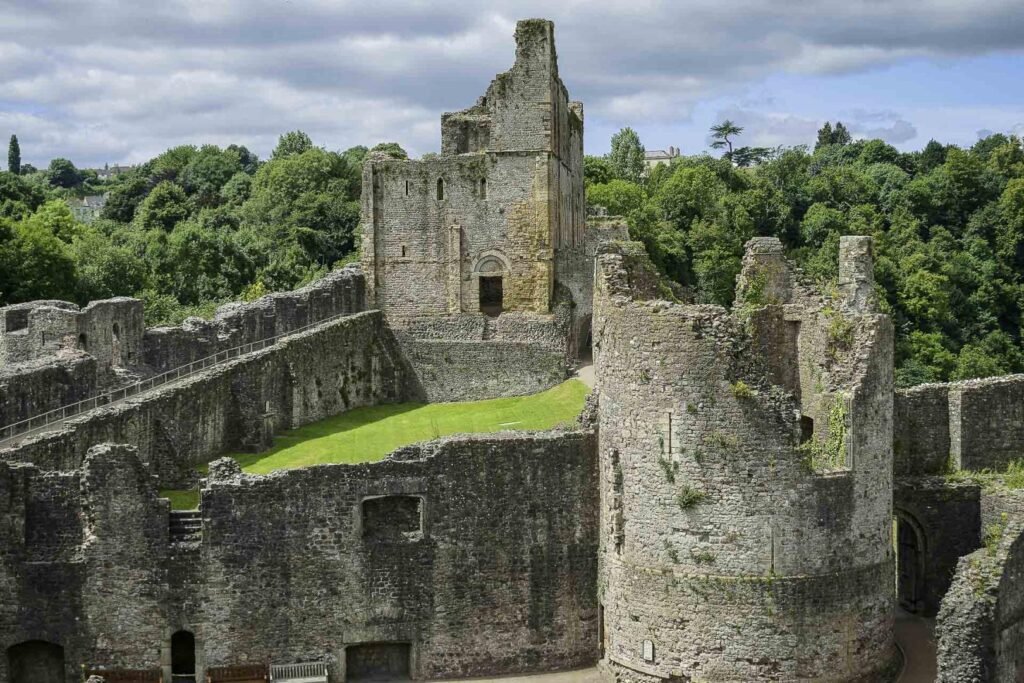
Castles Built Along Key Trade Routes and Waterways
The Normans also fortified border regions to secure their territories and prevent Welsh attacks. These strategic castle locations acted as a defensive barrier against Welsh threats. Abergavenny, built around 1087, and Builth, initially constructed in 1100 and fortified by King Edward I in 1277, were key in these areas.
“The Norman castle-building campaign dramatically transformed the architectural and strategic landscape of Wales, cementing Norman authority through imposing architecture and psychological intimidation.”
Fortifications Constructed in Border Regions and Coastal Areas
Coastal castles were a vital part of the Norman strategy in Wales. These fortifications, like those built during Edward I’s campaigns, facilitated sea resupply and bolstered military presence. Beaumaris Castle, begun in 1295, was the last and largest of Edward I’s castles in Wales, highlighting the importance of coastal fortifications.
Over two centuries after the Norman invasion in 1066, over 150 castles were built in Wales. This extensive network played a vital role in subjugating Welsh territories, lasting over 200 years. Today, these castles along trade routes and in border regions and coastal areas stand as testament to the Norman legacy. Some, like Caernarfon and Conwy Castles, are UNESCO World Heritage Sites.
The Impact of Norman Castles on the Welsh Landscape and Society
The Norman conquest of Wales in the 11th and 12th centuries profoundly changed the landscape and society. The construction of imposing castles was key, symbolising Norman power and control. These castles were built to assert dominance over Welsh territories.
Normans expanded their influence through a network of lordships and barons. These Marcher aristocrats built many castles. They served as administrative centres, military strongholds, and symbols of authority. The Welsh landscape was dramatically altered, with castles’ towering walls and keeps dominating the countryside.
The influence of Norman castles went beyond the physical landscape. They reshaped Welsh society, influencing land ownership, political structures, language, and culture. The Normans introduced new governance, law, and taxation systems. These changes gradually eroded traditional Welsh customs and ways of life.
“The construction of Norman castles had a profound impact on the Welsh landscape and society, transforming the physical environment and reshaping social, economic, and political structures.”
Recent research has highlighted the extent of Norman castle-building in Wales. Surveys in the Gower Peninsula show nearly all ecclesiastical sites were linked to Norman castles. This suggests a coastal chain of early castles, showing the Normans’ strategic focus on castle construction to control Welsh lands.
The legacy of Norman castles in Wales is evident today. Many are now tourist attractions and historical sites. From Caernarfon Castle’s grandeur to Criccieth Castle’s picturesque ruins, they remind us of the Norman influence. They also highlight the transformative impact on Wales’ landscape and society.
The Legacy of Norman Castles Built in Wales
The Norman castles built in Wales are lasting symbols of a tumultuous period in the nation’s history. These fortresses, constructed to assert Norman dominance, have profoundly influenced Wales’s architectural heritage. Today, they attract tourists and serve as historical sites, revealing the complex Norman-Welsh dynamics.
The UNESCO World Heritage Site “Castles and Town Walls of King Edward in Gwynedd” showcases the impact of Norman castles. It includes Conwy, Caernarfon, Harlech, and Beaumaris castles. These structures, with their robust stone walls and high keeps, were built to endure military attacks and time. Their presence highlights the Normans’ significant influence and their role in shaping Wales’s history.
Castles as Tourist Attractions and Historical Sites
Norman castles built in Wales have become major tourist draws, drawing visitors globally. Cadw, the Welsh government’s historic environment service, manages many castles, ensuring public access. Visitors can explore the grounds, climb the battlements, and dive into the history of these structures.
As a child, I spent many happy years touring welsh castles with my family. My personal favourite is Pembroke Castle.
These castles are more than tourist spots; they are key historical sites. They offer a glimpse into the medieval Wales’s politics, society, and culture. Scholars study these castles, gaining insights into the lives of those who built, inhabited, and defended them.
The Enduring Influence of Norman Architecture in Wales
These are not just historical landmarks but also showcase Norman architecture’s lasting impact. The Normans introduced stone construction, the keep, and elaborate gate houses and walls. These innovations influenced Welsh castle design, even by native rulers.
The adoption of Norman building methods by Welsh princes shows the lasting influence of Norman castle-building. This highlights the significant role of Norman architecture in Wales’s built environment.
Exploring the legacy of Norman castles in Wales deepens our understanding of history, architecture, and cultural identity. These structures, enduring through time and change, symbolise the Welsh spirit and their rich history.
Top 5 List Of Norman Castles Built In Wales
Here’s the top 5 list of well preserved and impressive Norman Castles built in Wales (in order of preservation). if you don’t find the castle photo below, the castle is referenced and an appropriate photo found above.
Conwy Castle
Built between 1283 and 1289 by Edward I, Conwy Castle stands as one of Wales’s best-preserved fortresses. With its towering walls and striking views over the River Conwy, this castle is a true masterpiece of medieval engineering. Every inch of Conwy feels like stepping back in time, its walls and towers almost untouched by the centuries.
Caernarfon Castle
Caernarfon Castle, built in 1283, is a sight to behold. Its unique polygonal towers and sheer scale make it a formidable presence on the Welsh landscape. Edward I’s vision of power and intimidation is perfectly preserved here, as this castle’s structure remains impressively intact, commanding attention from every angle.
Beaumaris Castle
Known for its perfect concentric design, Beaumaris Castle, started in 1295, is one of Edward I’s architectural marvels. Though left unfinished, its preservation is remarkable, showcasing the Normans’ advanced understanding of defensive strategy. Walking through Beaumaris, you’ll feel the might and meticulous planning of the Norman era. Image below:
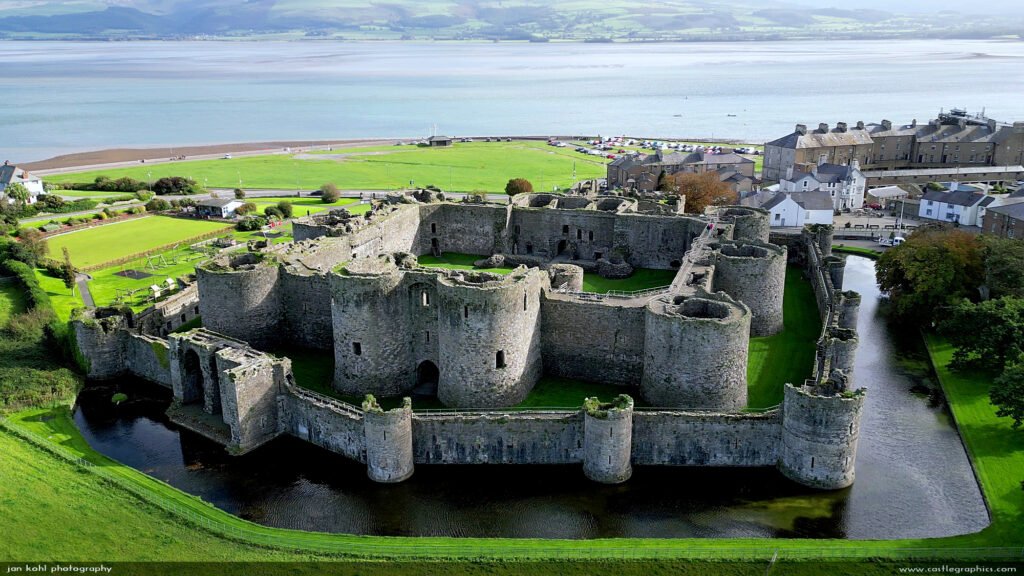
Harlech Castle
Perched high on a rocky outcrop, Harlech Castle, built between 1283 and 1290, is as breathtaking as it is well-preserved. Its rugged setting and sturdy towers give it an almost mythical quality. Harlech was designed not just to withstand the elements but to endure the centuries, and it’s done just that.
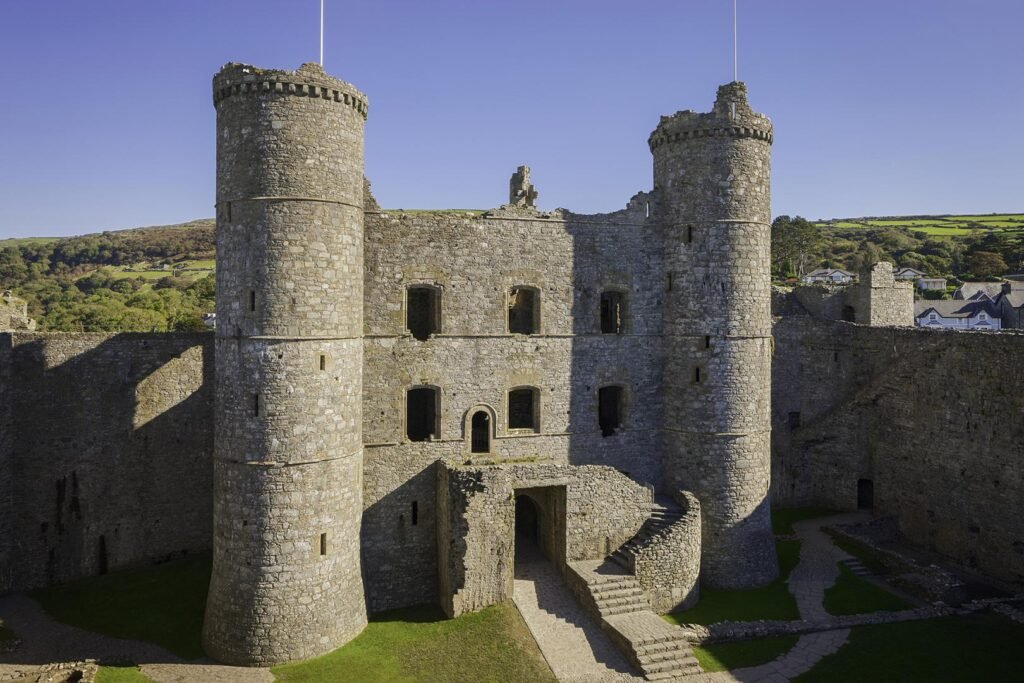
Pembroke Castle
Originally a timber fort built around 1093, Pembroke Castle was later rebuilt in stone, transforming it into one of Wales’s finest Norman strongholds. Its iconic round keep, soaring above the surrounding landscape, remains incredibly well-preserved. Pembroke is more than a fortress; it’s a piece of living history.
Key Takeaways
- The Norman invasion of Wales led to the establishment of marcher lordships and castles, solidifying Norman control over Welsh territories.
- Norman Castles built in Wales initially started as motte-and-bailey structures, later transitioning to stone constructions for enhanced durability and defence.
- Medieval castles in Wales were strategically located along trade routes, waterways, and border regions to maintain Norman influence and control.
- Native Welsh princes resisted and adapted to Norman castle-building, with some adopting similar techniques for their own fortifications.
- Norman military architecture in Wales not only served defensive purposes but also functioned as centres of administration, justice, and trade, shaping medieval Welsh society.
Conclusion
The Norman castles built in Wales are more than just stone walls and towering keeps; they’re the silent witnesses to a time when Wales was a battleground of ambition, resistance, and resilience. Each castle tells its own story of power, defiance, and cultural transformation.
From the strategic brilliance of Edward I’s fortresses to the adaptations made by Welsh rulers, these castles have shaped not only the landscape but also the very identity of Wales itself. Today, as we walk through the corridors and courtyards of these ancient strongholds, we’re stepping into the echoes of a past that was as tumultuous as it was transformative.
These castles stand as a testament to the endurance of the Welsh spirit and the indelible mark the Normans left on this land. Whether looming over a rugged coast or perched on a hillside, the Norman castles built in Wales continue to capture our imagination, reminding us that history is not just a story—it’s a legacy etched in stone.
Matt






